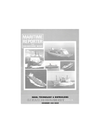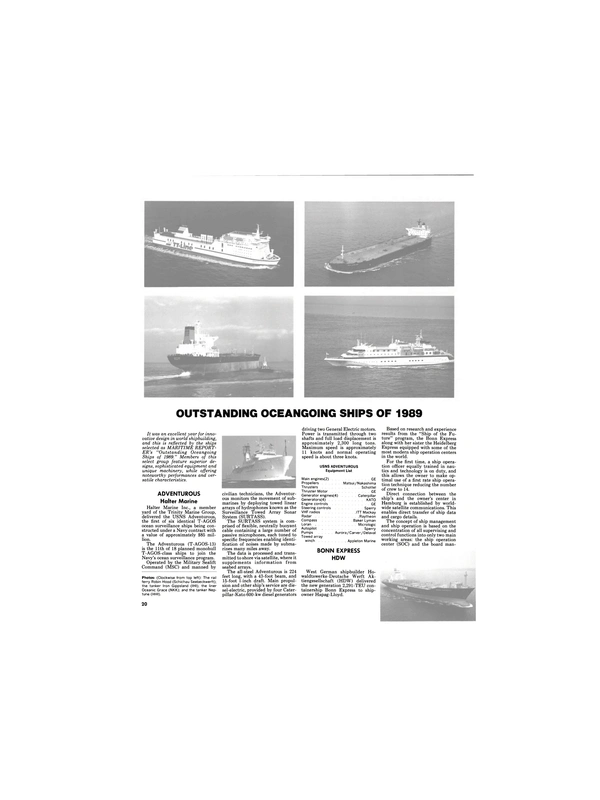
EUROPE 1992: WHAT LIES AHEAD FOR U.S. COMPAHIES?
In all probability, the changes taking place in Europe will have a profound impact on the way ocean carriers do business in the years ahead.
Of course, no one can predict exactly what the European economy will look like in 1992. While many people expect the European Community to achieve full economic integration, it is unrealistic to assume that one unified market—where goods, services, capital and labor flow unrestrained—will be created by the end of 1992. Policies are still being set, and the true shape the market and its full impact on the business world is largely unknown.
The exact timetable for Europe aside, we are clearly in a business environment that is taking on global dimensions. Europe is on its way to becoming a four trillion dollar market—that's four thousand billion— made up of 320 million consumers.
Europe's drive toward a single market is accelerating a move toward the creation of three global trading blocs—North America, Asia and Europe. Gross domestic product in the Common Market will soon rank with that of the U.S.; it is already larger than Japan's.
Some important steps have already been made as European countries prepare for life after 1992.
Many of the nearly 300 trade directives are being dismantled, eliminating cumbersome standards and regulatory procedures.
As we get closer to 1992, one significant development is the possible integration of 12 heterogeneous markets into one large market for goods and services. Companies around the globe will be looking at what could become the largest single customer base in the world.
We see a number of opportunities and some obstacles for American businesses. The unification of Europe should compel American businesspeople to look at the world as they never have before. After all, what we're seeing in Europe represents the first situation in decades where American companies will not play a leading role in a significant development in world trade. In the next five years, we expect that events in Europe will not have a dramatic impact on trade into and out of the U.S.
The changes in Europe should make it easier for firms to do business.
In fact, a U.S. government official recently said that American companies currently operating in Europe will not have to change much and that little, if any, additional investment will be required.
This might be true in some cases.
But part of the ground rules for doing business in Europe will change, forcing both European and foreign firms to change the way they do business.
It's likely that all traditional forms of distribution in Europe will be subject to change. The question is, "Will American companies be on the forefront of this change, or will they be on the outside reacting to the competitive moves of others?" American companies must stay on top of new transportation developments.
Logistics will become a powerful marketing tool. Foreign firms will no longer be able to survive unless they are constantly aware of both their customers' needs and what the competition is doing.
Not only must companies know their customers's needs, but they also must know the needs of their customers' customers' in order to fully understand the complete distribution cycle.
To succeed in Europe, American companies will have to adopt a new approach to doing business. This will not be an easy transition to make. Americans are used to thinking in terms of world trade evolving in the U.S. Now they have to start thinking about how to capitalize on trade opportunities revolving in Europe.
American businesses planning to expand in Europe must consider forming ventures with their European counterparts. These linkages may take the form of alliances, partnerships or acquisitions, or they may even be start-up companies.
We must figure out how to wed our strengths with those of European companies. American companies can bring to the table decades of experience in serving one large market. Europeans, on the other hand, can offer both local expertise, and in some cases, a different world perspective.
So real opportunities in world trade in the near term are going to take place in Europe. However, over the longer term, by 1994 or so, we expect to see greater demand for American products in Europe. Given the marketing experience of U.S.
firms, the unification of Europe's markets should work to our advantage.
After all, American companies have more experience than anyone in selling to one large market—our own. And it's easier than earmarking a message specifically for Dutch, French or Italian consumers. But again, we don't see this market growth beginning for three to five years.
We see a number of opportunities for exporters and carriers who wish to operate throughout Europe. One is increased intermodal traffic throughout the community as shippers find it easier to move their products farther inland. A second opportunity is for increased intra- European trade. This larger volume will invite more competition in each transport mode, as well as between modes.
In fact, Europe is already taking steps to facilitate the movement of goods around the community. Many observers believe that by 1992, a number of substantial improvements will be made in European transportation infrastructure.
We would welcome these improvements.
Europe's infrastructure does not allow for the sophisticated transportation systems we have in the U.S. The roads are too narrow and the tunnels too numerous to accommodate heavy trucking.
Yet about three-quarters of the cargo moved in Europe travels over the road. Nor are the railroads as efficient as they are elsewhere. In fact, goods in Europe travel at an estimated seven miles an hour, compared with an estimated 36 miles an hour in the U.S.
As we face these developments in Europe and the globalization of the world, it's important that shippers and carriers work together. Carriers need to make more of an effort to understand their customers' needs.
Customers, on the other hand, should be willing to look at longer term relationships with carriers. By developing a close working relationship, carriers and customers can, through technology and creative approaches to logistics, make a customer's product as competitive as possible in every way—quality, price, and availability.
Read EUROPE 1992: WHAT LIES AHEAD FOR U.S. COMPAHIES? in Pdf, Flash or Html5 edition of December 1989 Maritime Reporter
Other stories from December 1989 issue
Content
- IMO Delaval Names Three New Managers For Turbine Division page: 8
- Manitowoc Engineering Names Fox Executive VP And General Manager page: 9
- Ocean Survey Ship, USNS Tanner, Launched By Beth-Sparrows Point page: 9
- Avondale Industries Christens N a v y ' s Newest Fleet Oiler, USNS Pecos ( T - A O - 1 9 7) page: 10
- Emergency Rescue Beacon Introduced By Litton To Aid Mariners In Distress page: 10
- Nine M A N B & W Holeby GenSets Ordered For Three Containerships To Be Built At Odense Shipyard page: 11
- MarAd Repair Subsidy Proposal Opposed By U.S. Shipbuilders page: 11
- WORLD SHIPBUILDING A MARKET POISED FOR RAPID TAKE-OFF AND SUSTAINED GROWTH page: 12
- U.S. YARDS COULD COMPETE WITH EUROPE IN 1990s* page: 14
- A SHIPBUILDER'S PERSPECTIVE page: 16
- THE SHORT CRUISE MARKET IH EUROPE AHD HORTH AMERICA page: 17
- EUROPE 1992: WHAT LIES AHEAD FOR U.S. COMPAHIES? page: 18
- OUTSTANDING OCEANGOING SHIPS OF 1989 page: 20
- A STATUS REPORT ON NAVY SHIPBUILDING AND REPAIR page: 27
- $23-Million Navy Contract Awarded Avondale To Enlarge Auxiliary Oiler page: 33
- U.S. Coast Guard Patrol Boats To Be Repowered W i t h Cat Engines page: 34
- Fincantieri Launches 'Scarabeo 5' Semisubmersible Drilling Rig page: 45
- Autronica Receives Order For Radar-Based Level Gaging Systems page: 47
- Cummins-Powered 'Grand Romance' Begins Excursion Service On St. Johns River In Florida page: 48
- Australian Admiral Test-Starts New Sub Engine At Hedemora Diesel—Literature Available page: 48
- W a r t s i l a Diesel Repowers Seattle Fishing Vessels page: 49
- MSI/CAORF Trains How To Avoid Ship Accidents Before They Happen page: 49
- Workboats Northwest Delivers Versatile 58-Foot Fishing Vessel page: 49


